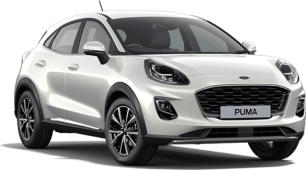Compact yet spacious, the ST-Line V's interior has strong as well as weak points.
Let's start with the latter. The most obvious connection with the Fiesta is in the Puma's dashboard, which is largely shared between the two. After all the effort expended on the design and chassis, this is somewhat disappointing. There's nothing wrong essentially with the fascia's aesthetics or functionality – it's just that the look is humdrum and dated. What's needed is something with the visual wow factor as found in the latest Peugeot 2008, especially at this price point.
Yet Ford has at least tried to put some tinsel inside this most expensive version of its smallest SUV.
Stitched perforated leather seat facings, carbon-fibre-look trim and soft vinyl coverings in key touchpoint areas bring an upmarket look and feel, backed up by a now-familiar digital instrumentation layout, a lovely flat-bottomed three-spoke steering wheel, easy and intuitive multimedia interface and a wireless phone charger. That electronic cluster, by the way, changes colour and markings but doesn't have the scope of multimedia displays of, say, Audi's Virtual Cockpit. It's comparatively rudimentary.
Conversely, there's a solidity and quietness as well, offering a level of refinement that's usually found in more-premium Euro alternatives. We weren't expecting that, though of course this is a German Ford product.
Our test car also boasted a vast glass opening sunroof, adding to the opulence. With all this gear, the ST-Line V's cabin is properly appealing.
On the practicality front, entry and egress is pretty good, the driving position is excellent (thanks in no small part to a big amount of adjustability for both the steering column and seats), the front cushions themselves are sumptuously enveloping, while wide door pockets and a big glovebox obviously come in useful. And there's a USB-C outlet in the centre cubby between the seats. How modern.
However, rear vision out is poor, there are no seat warmers and some of the lower-lying plastics are a bit drab.
The back seat isn't really suitable for people over 175cm, as kneeroom is limited and taller scalps may scrape the ceiling with the twin-pane sunroof in situ. The latter also means no overhead grab handles.
But the backrest angle and cushions themselves are fine, even for longer journeys. Just don't expect to squeeze a third adult in the back unless rubbing shoulders won't bug you. Note, too, that the rear cushion does not slide or tilt forward to allow for a lower load area when the backrest is folded down. Pity.
There is a receptacle in both doors for small bottles but no cupholders whatsoever (how can Ford call itself an American company?), or face-level air vents – though the large dash vent outputs do reach the rear. Amenities such as USBs and cupholders are AWOL; and vision out from back there is limited by the high shoulder line. Tough if you're trying to peer out. Sorry, Fido.
The Puma's overall compact footprint and rear packaging clearly suggest that this is aimed at singles, couples, or couples with smaller kids/pets to transport around.
Still, for a small SUV, the cargo area isn't bad at all. The standard floor depth is fairly generous, with a long and flat loading area, but below that is a narrower yet deeper waterproof area, while under that again is a space-saver spare wheel. Clever. Also intelligent is the luggage cover that lifts automatically with the tailgate, as per Mazda's CX-5.
For the record, cargo capacity is rated at 410 litres with the 60/40 split-fold rear seats erect – or 1170L with them folded down flat. These figures far outstrip the CX-3.
To sum the cabin experience… it's far-better than its Fiesta-sourced dashboard may suggest, while the ST-Line V treatment goes a long way in helping justify the premium. That's a win.






